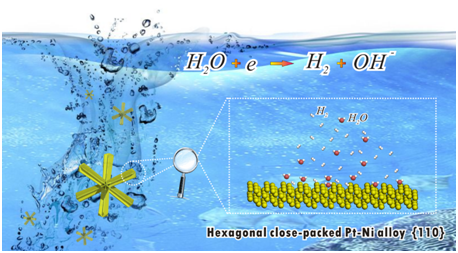Progress about the regulation of crystal phase of the Platinum-based nanocrystals
Recently, new progress about the regulation of crystal phase of Platinum-based nanocrystals was made by the cooperation between Prof. Zhaoxiong Xie's and Prof. Gang Fu's groups from Xiamen University. The study, titled “Platinum-nickel alloy excavated nano-multipods with hexagonal close-packed structure and superior activity towards hydrogen evolution reaction”, was published on the Nature Communications (DOI:10.1038/ncomms15131).

Noble metal based nanomaterials are promising functional materials, which have potential applications in many important fields. The discovery of their new crystal phase provides an opportunity for achieving novel functionalities due to different atomic arrangements and electronic structures of allomorphs, and thus possesses great significance. Pt-Ni alloy is one of the best catalysts for many energy conversion applications, such as oxygen reduction (ORR) and hydrogen evolution (HER). In the past few decades, great efforts have been devoted to improving the catalytic efficiency through tailoring the size, morphology and composition of Pt-Ni alloy NCs, but all the reported Pt-Ni alloys adopt the typical face-centered cubic (fcc) crystal phase. The regulation of the crystal phase of Pt-Ni alloys was unrevealed.
Recently, Xie, Jiang and Fu et al report a successful synthesis of metastable hexagonal close-packed (hcp) Pt-Ni alloy nano-multipods in a mild solvothermal condition for the first time. Detailed analysis showed that the building blocks of Pt-Ni alloy nano-multipods were highly-concave hexagonal prisms assembled by six nanosheets of about 2.5 nm in thickness and exposed with (11-20) facets. Owing to the unique crystal structure and large surface area due to the excavated polyhedral morphology, the hcp Pt-Ni alloy excavated nano-multipods exhibited a superior catalytic ability towards the HER. The specific area current density of hcp Pt-Ni excavated multipods at -70 mV is respectively 4.1 and 1.8 times higher than that of commercial Pt/C and their fcc counterpart. The mass current density of the as-prepared hcp Pt-Ni excavated nano-multipods reaches 3.28 mA μgPt-1, which outperforms the currently reported catalysts.
This work was supported by the National Basic Research Program of China, the National Natural Science Foundation of China, and the Natural Science Foundation of Fujian Province of China.
Paper link: https://www.nature.com/articles/ncomms15131